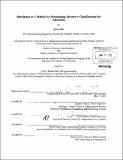Simulation as a Method for Determining Inventory Classifications for allocation
Author(s)
Ball, Braden (Braden R.)
DownloadFull printable version (5.852Mb)
Other Contributors
Leaders for Global Operations Program.
Advisor
Stephen Graves and Chris Caplice.
Terms of use
Metadata
Show full item recordAbstract
Companies that utilize multiple facilities to satisfy customer demand are faced with the same basic question - where should inventory be held? This thesis presents a method for answering this question, specifically for a company that allocates multiple units across multiple facilities, where any facility can fulfill an order to any customer, though with differing shipping costs. The model presented is a simulation of the shipping costs of various allocation strategies across a range of allocated inventory quantities, where the strategies simulated include consolidating all inventory in a central facility, constraining inventory to regional hubs, and spreading inventory throughout the network. The simulated results are then compared to find the low cost allocation strategy at a given level of allocated inventory. With this comparison, product groupings with the same low cost allocation strategy are identified, and are defined as "Slow", "Medium-A", "Medium-B", and "Fast" products. These groups can then be used to manage the allocation process, where "Slow" inventory is held centrally, "Medium-A" inventory held regionally, and "Fast" inventory spread throughout the network. "Medium-B" items serve as a costmitigating flexible option, where they are spread throughout the network when possible but consolidated when necessary to avoid changing the allocation for "Fast" items. At a broad level, the model presented is applicable to any company that can fulfill demand to a single customer from multiple facilities.
Description
Thesis (M.B.A.)--Massachusetts Institute of Technology, Sloan School of Management; and, (S.M.)--Massachusetts Institute of Technology, Engineering Systems Division; in conjunction with the Leaders for Global Operations Program at MIT, 2012. Cataloged from PDF version of thesis. Includes bibliographical references (p. 54-55).
Date issued
2012Department
Leaders for Global Operations Program at MIT; Massachusetts Institute of Technology. Engineering Systems Division; Sloan School of ManagementPublisher
Massachusetts Institute of Technology
Keywords
Sloan School of Management., Engineering Systems Division., Leaders for Global Operations Program.